
Northern Section
Northern Section
THE AURICULA SCENE
Brian Coop
As we leave behind the celebrations of our 150th Anniversary, it seems an appropriate time to assess where the Auricula stands at present. Over the next few months it is planned to run through the different classes of Auricula and advise on what is available and worth growing for showing. We already have an overview of the 'Types of Auricula' on the website, so the classes are those seen in the Show schedule e.g., Green Edged Auricula, Gold Centred Alpine, Double or Striped.
Red Self Show Auriculas
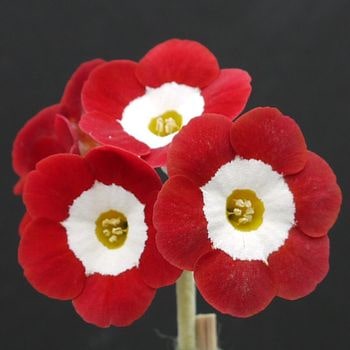
Knights
I consider the Red Self to be the doyen of the Selfs, because of their richness and intensity of colour. They have a long history, and I was surprised to see this manifested in one nursery list in the form of Fanny Meerbeck. Raised in the 1890s, this was old when I first started growing. Its parentage is unknown, but it has been known to throw a yellow pip, or a red pip with a yellow stripe in it. Next in age comes Alice Haysom, listed by two nurseries, raised in the 1930s, a brighter red but lacking in quality. It is good that nurseries continue to stock these varieties, even though superseded, because I know that there are many reasons why people are looking for varieties other than putting them on the show bench.
We are fortunate with the Red Selfs because there does seem to be a good range listed, including quality varieties, although these are too often marked 'out of stock'. There are middling ones like Redgauntlet, Mohave, Lechistan and Favourite that have either had their day or were not quite good enough in the first place. Then there are more modern, quality varieties, like Scorcher, Royal Mail and Simply Red, the latter perhaps lacking in brightness.
Geronimo is also still available. In the 1970s Geronimo and Cheyenne were the dominant reds. Both were raised by Peter Ward and were virtually identical. Of great form they won many prizes over several years, but they lacked brightness, and the search was on to find a brighter red. This took several years, often involving Pat which was a bright red but also had faults that carried into its offspring.
It was Trevor Newton from the Northeast who made the break though with his Red Sonata and Red Ember, bright reds of good form. I haven’t seen these for a few years, but they did enable my father and myself to cash in with our own bright red varieties, principally Scorcher and Royal Mail. Both are still available; Scorcher is the brightest and a reliable flowerer whereas Royal Mail has slightly better form but has been more difficult to get on the show bench.
Trevor, however, had the last laugh, as, in the mid-1990s, he made a yellow x red Self cross to produce Knights. This has remained the dominant Red over the last 20 years. It grows well, offsets readily and can be relied on to produces a good truss of pips held well above the foliage. Given this, I was surprised to find that it didn’t seem to feature in any of the Nursery lists that I looked at. But keep looking for it because it is worth the wait.
Trevor continued to produce Red Self seedlings, mostly using Knights as a parent but none have become established to date and are unlikely to be in commerce. Likewise, Bob Taylor has produced some good quality seedlings of a rich red colour. These are still being grown on and much hybridisation is underway to make new Red Self varieties available.
One issue that can be contentious with the Selfs is where the boundaries of the recognised Class colours lie. Within the Red Selfs, Dark reds can look sumptuous, but do not fit easily into the class, the darker ones maybe qualifying better for the Dark Self Class. Likewise, a touch of pink tends to detract from the intensity of colour in the Reds and moves the variety towards the Any Other Colour class. A tinge of orange is acceptable, and this can be noticed if you compare Scorcher with Royal Mail.
Next month we will look at the Blue and Dark Self Show Auriculas.
Yellow Self Show Auriculas
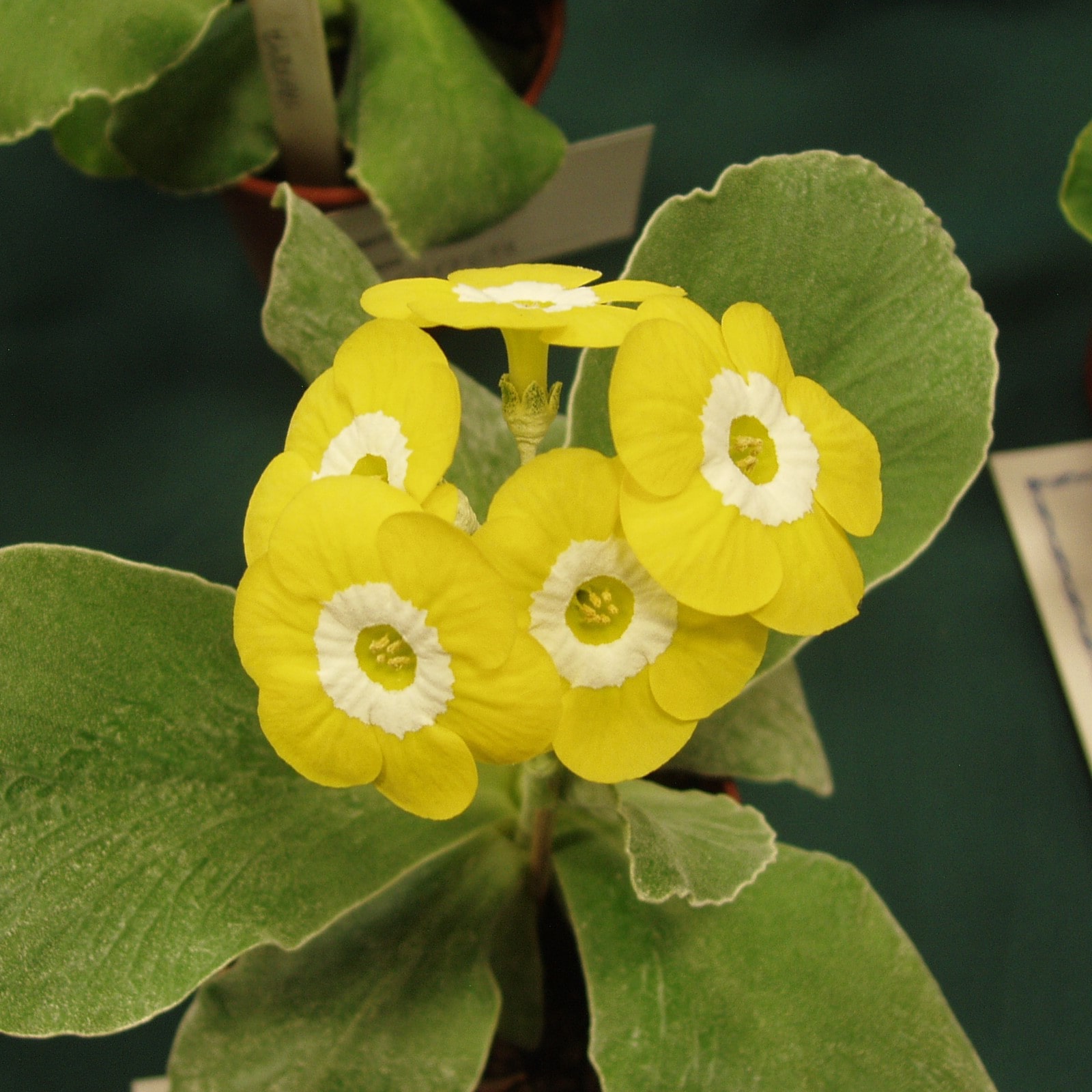
April Moon
Looking over the websites of those nurseries selling Auriculas I was surprised to find how few Yellow Selfs are listed and how far too many of the varieties in general are either Sold Out, not available or not yet ready for sending out. Neither would I hold forth the Society as a saviour, as there are few large collections of Show Auriculas still around and even these are at the mercy of the increasingly unpredictable weather. However, getting together a good collection of Auriculas has never been easy and persistence will pay dividends.
The Yellow Selfs should be the most numerous, being the colour of Primula auricula itself. Yet in Primula pubescens, its natural hybrid with Primula hirsuta, the petal becomes pigmented with the purple hirsutin. This combination was used by the hybridists to create the range of colours that we see in the modern Auricula. But it then became difficult to fix a true yellow in acceptable form. There were early yellows, yet even in the early twentieth century the class included maize and other impure shades. It could be regarded as coming of age with two varieties from Cyril Haysom in the 1950s, Ower and Melody. Others soon followed with Leeside Yellow from Dr Newton and Goldilocks and Queen of Sheba from Fred Buckley.
By the mid-seventies we had two of the finest Yellow Selfs ever raised, Tracy Ward from Peter Ward and Brompton from David Hadfield. Tracy Ward unfortunately faded away too soon, but Brompton dominated the class for many years. Both Peter and David used a Yellow Self to leaven the Edged plants that they put up in the multiple classes and make the entry more representative. Upton Belle, raised 50 years ago from unpromising parents, was not far behind in quality; it had an opulent flower but was an awkward grower and I haven't seen it for several years.
Forty years ago, my father, Tim Coop made a cross which provided us with many of the Yellow Selfs for the years to come. This was Moonglow x Helen, and it produced, April Moon, Corntime, Party Time, Lemon Drop, Moneymoon, Tomboy and Sherbet Lemon. The use of Moonglow, which is pale enough to be classed as an 'Any Other Colour' caused these to be of a paler shade than many previous yellows. A number are still around, including Helen; April Moon was probably the best, but Sherbet Lemon had petals like satin. Corntime seemed to develop later than the others and Chris Gill used it several times in his Show multiples.
Brasso, from my father, came slightly later, from Moonglow, but this time crossed with Upton Belle, the cross producing a reliable bright yellow. Brasso has stood exhibitors in good stead for the 'Matched Pair' class at the Midland and West Show, readily producing a good truss held well clear of the foliage.
Another raised about the same time was Golden Fleece from Les Kaye. This again is a bright yellow and looks to be still available. The one that maybe easiest to obtain is Piccadilly from Henry Pugh which is listed by more than one nursery. Ken Bowser's Sharon Louise has the best form of our modern Yellow Self, and has won many prizes. It has however always been a bit chary of offsetting and you will be very lucky if you get a plant.
If you are struggling, then nil desperandum; The Baron looks to be still available. It is more of a maize colour, but I have a picture of my father and I from 35 years ago, looking askance at a large and good quality Yellow Self class won by 'The Baron'!
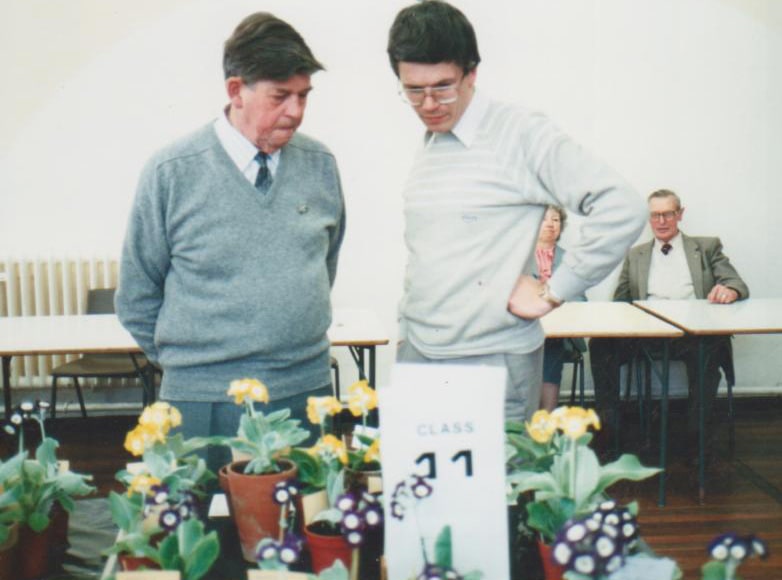
Tim and Brian Coop
Next month we will look at the Red Self Show Auricula.
Grey/White Edged Show Auriculas
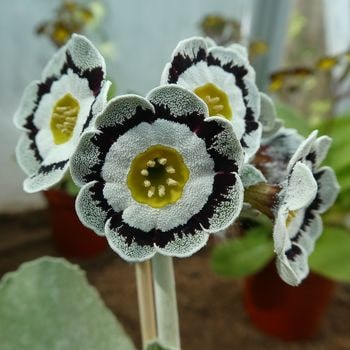
Mike Seel
Last month I hinted that these types were prized above the Green Edges by some because both the foliage and pips are covered with tiny little filaments which form the farina. This varies in consistency, by variety, from just a thin smattering over the green to a dense white paste. It is this contrast between the white edge and the black body colour that make these such striking plants. Those still showing the green underneath are not so highly prized. Others are on the borderline and can be shown in either the White Edged or Grey Edged classes.
As with the Green Edges, body colours other than black are acceptable in the Open classes, but there are none that have yet been bred to that standard and need to be shown in the Fancy classes. All Edged auriculas have body colour that flashes to the edge at times, purple, red, pink or yellow, the main criteria being that the contrast is striking.
We are still too dependent on the varieties raised by Peter Ward nearly 50 years ago and of these, Warwick and Gavin Ward have not been surpassed. Warwick still offsets well but is not as vigorous as it used to be and is difficult to grow to Show standard. Gavin Ward was always more chary of producing offsets, but the individual plants seem to sustain better than those of Warwick. It has won many Premiers although slightly let down by a crenated tube.
Of Peter’s others, Clare is probably the best although it is variable in form and its crenated tube can be too wide. Sharman’s Cross is nearer white and is above average, but it can be difficult to get a well formed truss. Brookfield is nearest white and probably because of this the pips tend to be smaller, the density of farina inhibiting their growth. It also has a tendency to produce a small supernumerary petal which upsets the symmetry. Having said that, it still wins on the Showbench and may be the easiest to obtain.
Of the true whites, James Arnot and Walhampton are probably now in the past. Ptarmigan can be a winner but is not easy to grow. Michael Wattam may be the easiest to obtain but is hardly of show quality. More recently Allan Guest has raised some White Edged seedlings, of which Mike Seel, named after an organiser of the Saltford Show, looks to be winning a prize or two.
Bob Taylor, past secretary and editor of the Northern Society raised a number of Greys which he named after Dad’s Army characters, including Corporal Jones, Sergeant Wilson and Pikey. Pikey is probably the best and has persisted longest. It is not an easy plant but should still be available.
There is another type of Grey where the beauty seems to be created by the underlying petal colour rather than the density of meal. Here, the edge looks to be leaded or like pewter, apparently dull, but making a variety of striking contrasts. The best of these, raised by David Hadfield, is Grey Hawk. It is more recent than some of the varieties mentioned here but is of a poor constitution and faded years ago.
A more recent example is Chris Gill’s Sea Peep. It is not of the same quality as Grey Hawk and the pips are smaller but it has this strange beauty and, more importantly it forms a good truss and is appearing in more exhibits. It is definitely worth obtaining.
Next month we look at yellow Show Selfs.
Green Edged Show Auriculas
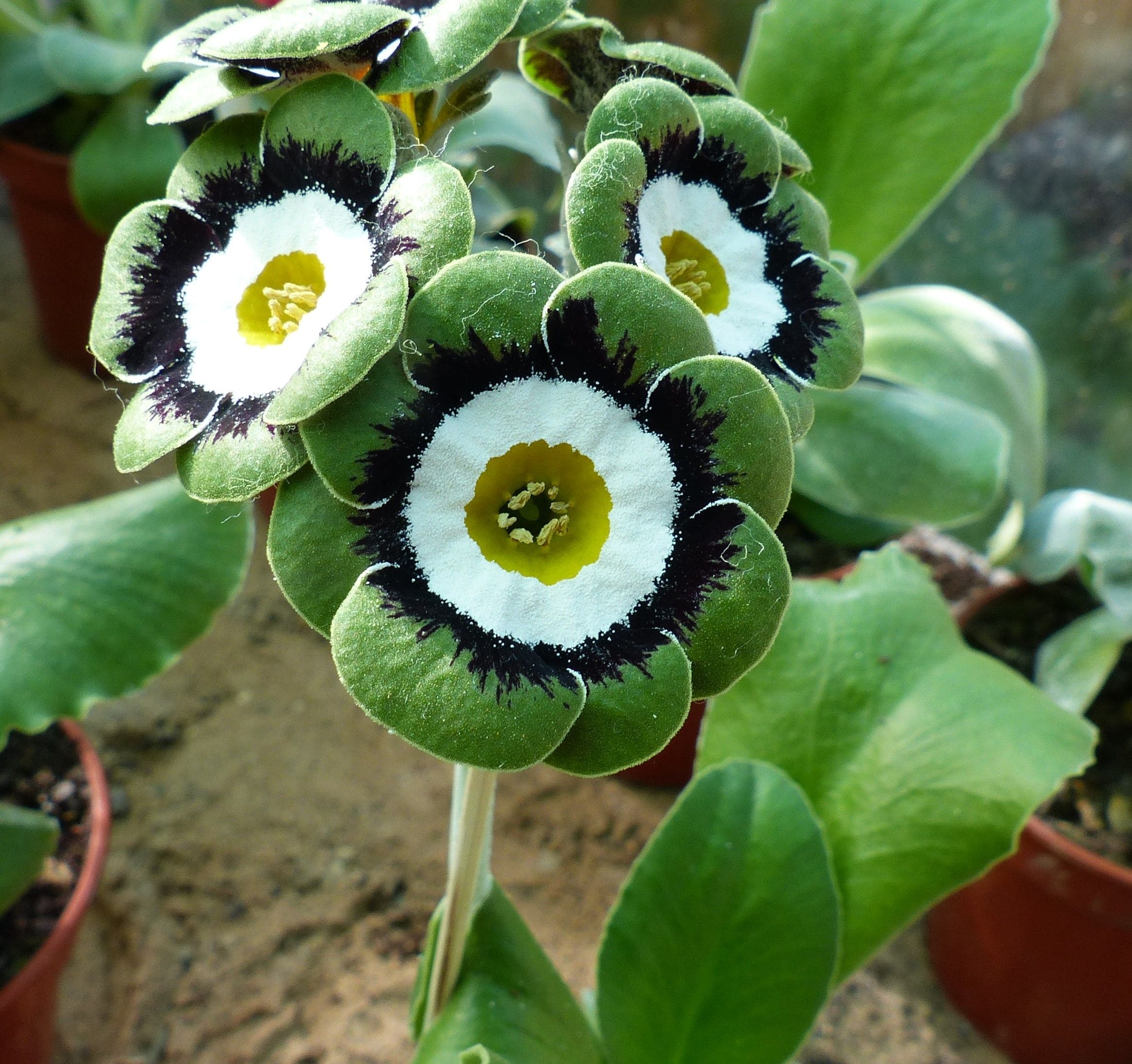
Prosperine
The Green Edged Auricula must be regarded as the acme of the Florist's art because of the way they have turned the chance occurrence of virescence in the pip into the refined green edge. Some regard the Grey/White Edge as more beautiful, and we will look at them next month. Many find them difficult to grow to Show standard and, as the Stripes and Doubles of the 17th and 18th century have been resurrected, growers have moved towards them. Others prefer just to grow the Show Self but not the Show Edged although the Show multiple classes are supposed to be representative of the type as, despite appearances they are closely related.
This can be seen in breeding where, despite 200 years of crossing Green Edges with one another, each cross will still produce Selfs, sometimes up to 25%. Equally a quality Green Edged, if not well grown will manage 2 or 3 good pips but will then run out of energy and the later ones are deficient in edge, showing too much body colour, moving towards a Self.
The body colour of most modern Green Edges tends to be black, or deep red, but it can be red, as in Rajah, violet as in Helen Barter, pink as in Astrolat or yellow as in Salad or Spring Meadows, with many others varieties available commercially. The problem is that all of these have body colour that flashes to the edge and are therefore classed as Fancies, because they do not conform to the Standard. Although Edges of other body colours than black are accepted in the 'Open' classes nobody has, to date, succeeded in raising one to that standard.
In recent times the peak of popularity was probably reached 40-50 years ago when the varieties Chloe, Fleminghouse and Roberto became more widely available and were shown in quantity. Certainly, Chloe and Roberto are still around although Chloe is losing vigour.
For 20 years up to 2000 we largely had to depend on the Northern Secretary, David Hadfield for keeping the Green Edges going as he raised superb varieties like Prague, Jupiter, Figaro and latterly Sappho and Tamino. These varieties are still in existence and may appear in commercial lists. Sappho was the top Green Edged up to 5 years ago. More recently, Bob Taylor raised quite a few Green Edges including Gruner Veltliner and Moselle during the 80s and Clipper in the 2000s. These again should be available from nurseries although they have the same problems in bulking stocks up as the amateur grower and will soon sell out.
My own efforts started with Benny Green around 25 years ago and this is listed commercially. It has been a reliable winner on the Showbench during that time although it can be difficult to get with more than 5 pips and maybe now past its best. Septimus Green was bred from this and is better, a reliable grower with more pips and better quality. To my knowledge it is not available commercially, but a number have been made available through Northern plant sales.
The other main contender is 'Prosperine', raised by Ken Whorton over 20 years ago. It is a small plant of excellent form which has won many awards and seems to be gaining in popularity.
So the number of show standard Green Edged varieties available is limited. There are many others that have been raised and fallen by the wayside over the years that still remain in nursery lists but I would not recommend them for show purposes.
The Auricula Scene
Brian Coop
As we leave behind the celebrations of our 150th Anniversary, it seems an appropriate time to assess where the Auricula stands at present. Over the next few months it is planned to run through the different classes of Auricula and advise on what is available and worth growing for showing. We already have an overview of the 'Types of Auricula' on the website, so the classes are those seen in the Show schedule e.g., Green Edged Auricula, Gold Centred Alpine, Double or Striped.
As we are a Florist's Society I will be looking at the varieties within these classes which meet the accepted Standards. I will include Border Auriculas which are judged for effect rather than to Standards. Gold Laced Polyanthus are also an important florist's flower within our Society although I will certainly have to seek advice on these.
I am aware that we have many new members within the Northern Society who wish to get started with exhibiting and are frustrated by the lack of quality material. The advice to new growers wishing to exhibit always used to be to look in the recent yearbooks to see which varieties have won on the Showbench. Yet within the last 10 years we have lost three specialist Auricula nurseries and the numbers of senior growers maintaining good collections has been thinned.
There are still a number of Nurseries that list large numbers of Auricula varieties to meet this increasing demand. Although top varieties may be listed there they are not quick to propagate and may be soon sold out. Otherwise there are many varieties that have been superseded, deteriorated through old age or which have never been successful on the showbench.
The main advice we can give is to get involved, go to the Shows, and have a go in the Beginner's classes. There is no harm in buying a general collection of Auriculas and showing them to the best of your ability. It is better to show an average variety in good form than a top variety poorly. This will be recognised by the established growers who will seek to encourage you and make the better varieties available.
